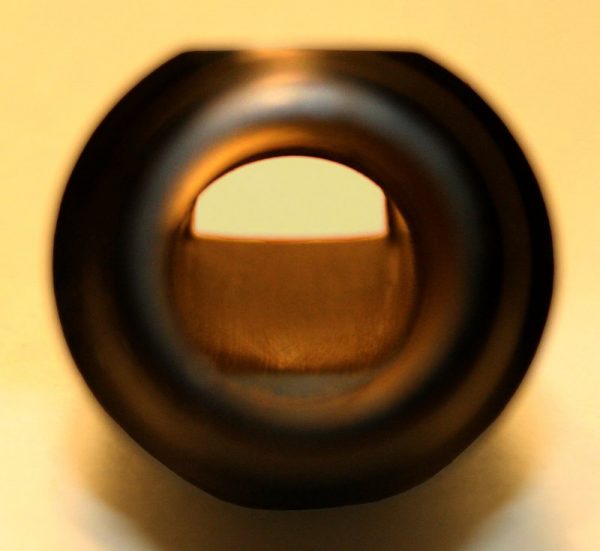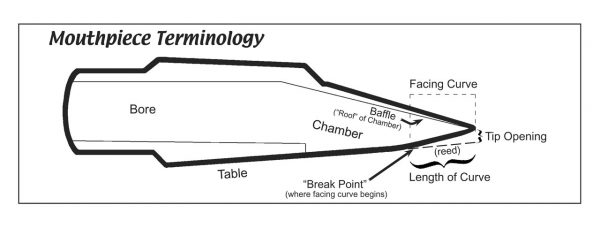Caravan Altsaxophon-Mundstück (Große Kammer)
Das Caravan Altsaxophon-Mundstück mit großer Kammer ist eines der harmonisch ausgewogensten und am besten ansprechenden Altsaxophon-Mundstücke auf dem Markt. Es erzeugt einen dunklen, „klassischen“ Klang, wobei die Tonkammer etwas kleiner ist als bei vielen Mundstücken mit offener Kammer aus der Zeit vor dem Zweiten Weltkrieg, die viele Spieler heute als zu einengend und „dumpf“ empfinden. Das Großkammer-Alt-Mundstück ist in einer Standard-Bahnöffnung erhältlich, die eine Öffnung von etwa 0,058 Zoll an der Mundstückspitze aufweist.
Das Ronald Caravan Saxophon-Mundstück
Ronald L. Caravan: „Erhältlich für Sopran-, Alt-, Tenor- und Baritonsaxophone, stellt dieses Mundstück eine moderne Manifestation des ursprünglichen Mundstückdesigns von Adolphe Sax dar. Die Charakteristik der „offenen Kammer“ (keine Konstruktion in der Tonkammer) sorgt für eine beträchtliche klangliche Tiefe und eine dunkle Qualität für die „klassische“ Performance auf dem Saxophon, aber die Tonkammer ist auch so dimensioniert, dass sie im Vergleich zu älteren Open-Chamber-Designs viel Kraft und Fülle bietet. Der wunderbar ausgewogene Klang, den dieses Mundstück erzeugen kann, kommt in erster Linie von der tiefen Schallwand und der runden Tonkammer, die sich nahtlos in die Mundstückbohrung einfügt.
Dieses Saxophonmundstück wurde entwickelt, um es dem Saxophonisten zu erleichtern, eine Klangqualität zu erzeugen, die den Klängen entspricht, die man bei anderen Holzbläsern in der symphonischen und klassischen Musik in Amerika hört – ein „amerikanischer“ Klang, der mehr oder weniger eine Synthese verschiedener europäischer „Schulen“ darstellt. Der Klang, den dieses Mundstück begünstigt, ist eine besonders attraktive Alternative zu den helleren, „metallischen“ Klängen, die im Allgemeinen mit der französischen Schule und den Mundstückcharakteristika, die diese hervorbringen, assoziiert werden – ein Klangkonzept, das im Allgemeinen bei anderen Symphoniemusikern in diesem Land keinen Anklang findet.“
Caravan Alto Saxophone Mouthpiece (Large Chamber)
The Caravan Large Chamber Alto Saxophone Mouthpiece is one of the most harmonically well–balanced and responsive open-chamber alto mouthpieces available. It produces a dark “classical” sound, yet the tone chamber is slightly smaller than many of the pre–World War II open–chamber mouthpieces that many players today find too restrictive and “tubby” sounding. The large–chamber alto mouthpiece is available in one standard facing that exhibits a tip opening of around .058 in.
The Ronald Caravan Saxophone Mouthpiece
Ronald L. Caravan: „Available for soprano, alto, tenor and baritone saxophones, this mouthpiece represents a modern manifestation of Adolphe Sax´s original mouthpiece design. The „open chamber“ characteristic (no construction in the tone chamber) provides for considerable tonal depth and darkness in quality for „classical“ performance on saxophone, but the tone chamber is also sized to allow for plenty of power and richness compared with older open-chamber designs. The beautifully balanced sound this mouthpiece can produce comes primarily from the deep baffle and round tone chamber that blends smoothly into the bore of the mouthpiece. Wider side and tip rails provide for greater purity in the tone and greater homogenity of color throughout the saxophone´s range.
This saxophone mouthpiece has been designed to make it easier for the saxophonist to produce a tone quality that corresponds appropriately to the sounds heard among other woodwind performers in symphonic and classical music in America – an „American“ sound representing, more or less, a syntesis of various European „schools.“ The sound this mouthpiece encourages is a particularly attractive alternative to the brighter, „brassier“ sounds generally associated with the French school and the mouthpiece characteristics that produce those results – a sound concept generally not found favour among other symphony musicians in this country.“
Boquilla Caravan para Saxofón Alto (Cámara Grande)
La boquilla Caravan de cámara grande para saxofón alto es una de las boquillas de cámara abierta para saxofón alto más equilibradas armónicamente y con mejor respuesta disponibles. Produce un sonido „clásico“ oscuro, aunque la cámara de tono es ligeramente más pequeña que muchas de las boquillas de cámara abierta anteriores a la Segunda Guerra Mundial que muchos músicos de hoy en día encuentran demasiado restrictivas y con un sonido „tubby“. La boquilla de gran cámara para alto está disponible en una cara estándar que presenta una abertura en la punta de alrededor de 0,058 pulgadas.
Boquilla para saxofón Ronald Caravan
Ronald L. Caravan: „Disponible para saxofón soprano, alto, tenor y barítono, esta boquilla representa una manifestación moderna del diseño original de Adolphe Sax. La característica de „cámara abierta“ (sin construcción en la cámara de tono) proporciona una considerable profundidad tonal y oscuridad en la calidad para la interpretación „clásica“ en el saxofón, pero la cámara de tono también está dimensionada para permitir un montón de potencia y riqueza en comparación con los antiguos diseños de cámara abierta. El sonido bellamente equilibrado que esta boquilla puede producir proviene principalmente de la profunda deflector y la cámara de tono redonda que se integra suavemente en el agujero de la boquilla. Los carriles laterales y de punta más anchos proporcionan una mayor pureza en el tono y una mayor homogeneidad de color en todo el rango del saxofón.
Esta boquilla de saxofón ha sido diseñada para facilitar al saxofonista la producción de una calidad de tono que corresponde adecuadamente a los sonidos escuchados entre otros intérpretes de viento madera en la música sinfónica y clásica en América – un sonido „americano“ que representa, más o menos, una síntesis de varias „escuelas“ europeas. El sonido que esta boquilla fomenta es una alternativa particularmente atractiva a los sonidos más brillantes y „brassier“ generalmente asociados con la escuela francesa y las características de la boquilla que producen esos resultados – un concepto de sonido que generalmente no se encuentra a favor entre otros músicos sinfónicos en este país.“



